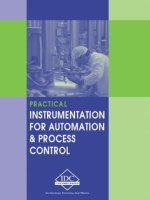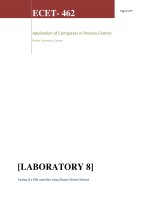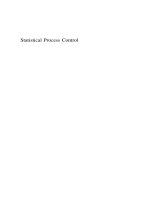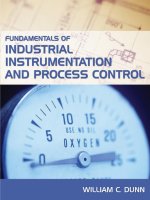Process control overview
Bạn đang xem bản rút gọn của tài liệu. Xem và tải ngay bản đầy đủ của tài liệu tại đây (2.61 MB, 126 trang )
<span class="text_page_counter">Trang 1</span><div class="page_container" data-page="1">
Instrumentation Diploma
●Concept of Process Control●Pressure Measurements
●Level Measurements●Flow Measurements
●Temperature Measurements●Control Valves
</div><span class="text_page_counter">Trang 2</span><div class="page_container" data-page="2"><b>Concept of Process Control</b>
<b>Moataz Sherif</b>
<b>Senior Instrumentation and Control Engineer</b>
</div><span class="text_page_counter">Trang 3</span><div class="page_container" data-page="3">Concept of Process Control
●Process Control Definition
●Basic Elements of Control Loop
●Open Loop and Closed Loop Control●Closed Loop Control Modes
●Sensors and Transducers
●Standard Instrument Signals●Smart Transmitters
<small>4</small>
</div><span class="text_page_counter">Trang 4</span><div class="page_container" data-page="4">Introduction
</div><span class="text_page_counter">Trang 5</span><div class="page_container" data-page="5"><small>6</small>
</div><span class="text_page_counter">Trang 6</span><div class="page_container" data-page="6">Industrial Instrumentation
●Once we measure the quantity we are interested in, we usually transmit a signal representing this quantity to an indicating or computing device where either human or automated action then takes place.
</div><span class="text_page_counter">Trang 7</span><div class="page_container" data-page="7">Industrial Instrumentation
●If the controlling action is automated, the computer sends a signal to a final controlling device which then influences the quantity being measured.
<small>8</small>
</div><span class="text_page_counter">Trang 8</span><div class="page_container" data-page="8">Control System
● A system which responds to inputsignals from the process and/orfrom an operator and generatesoutput signals causing the processto operate in the desired manner.● The control system include
○ Input devices○ Controller
○ Final elements
<small>Definition from IEC 61511-1</small>
</div><span class="text_page_counter">Trang 10</span><div class="page_container" data-page="10">Control System
Control system can be
●Programmable Electronic
Control system can used as a
●Basic Process Control System
●Safety Instrumented System
●Combined BPCS-SIS
</div><span class="text_page_counter">Trang 11</span><div class="page_container" data-page="11">Basic Process Control System
●Basic Process Control System (BPCS) is a system which responds to input signals from the process, its associated equipment, other programmable systems and/or an
operator and generates output signals causing the process and its associated equipment to operate in the desired
manner but which does not perform any safety
instrumented functions with a claimed SIL ≥ 1
<small>12</small></div><span class="text_page_counter">Trang 12</span><div class="page_container" data-page="12">Pneumatic Control System
</div><span class="text_page_counter">Trang 13</span><div class="page_container" data-page="13">Programmable Logic Control (PLC)
<small>14</small>
</div><span class="text_page_counter">Trang 14</span><div class="page_container" data-page="14">Turbo machinery Control System
</div><span class="text_page_counter">Trang 15</span><div class="page_container" data-page="15">Boiler Control System
<small>16</small>
</div><span class="text_page_counter">Trang 16</span><div class="page_container" data-page="16">Safety Instrumented System
SIS takes some other names●Trip and Alarm system
●Emergency Shutdown System (ESD)●Safety Shutdown System
●Safety Interlock System
●Safety Related Control System
</div><span class="text_page_counter">Trang 17</span><div class="page_container" data-page="17">BPCS vs. SIS
●SIS is a protection layer located to prevent the Hazards from occurring.
</div><span class="text_page_counter">Trang 18</span><div class="page_container" data-page="18">Safety Instrumented System
The system consists of ●Sensors
●Logic Solver
●Final control element
</div><span class="text_page_counter">Trang 19</span><div class="page_container" data-page="19">Process Control Definition
<small>20</small>
</div><span class="text_page_counter">Trang 20</span><div class="page_container" data-page="20">Process Control Definition
●A process is broadly defined as an operation that usesresources to transform inputs into outputs.
●It is the resource that provides the energy into the process forthe transformation to occur.
</div><span class="text_page_counter">Trang 21</span><div class="page_container" data-page="21">Process Control Definition
●Each process exhibits a particular dynamic (time varying) behavior that governs the transformation.
●That is, how do changes in the resource or inputs over time affect the transformation.
●This dynamic behavior is determined by the physical
properties of the inputs, the resource, and the process itself.
<small>22</small>
</div><span class="text_page_counter">Trang 22</span><div class="page_container" data-page="22">Process Control Definition
</div><span class="text_page_counter">Trang 23</span><div class="page_container" data-page="23">●The manipulated variable (MV) is a measure of resource being fed into the process, for instance how much thermal energy.●A final control element (FCE) is the device that changes the
value of the manipulated variable.
●The controller output (CO) is the signal from the controller to the final control element.
<small>24</small>
</div><span class="text_page_counter">Trang 24</span><div class="page_container" data-page="24">●The process variable (PV) is a measure of the process output
that changes in response to changes in the manipulated variable.●The set point (SP) is the value at which we wish to maintain the
process variable at.
</div><span class="text_page_counter">Trang 25</span><div class="page_container" data-page="25">Process Control Definition
●Process control is the act of controlling a final control element to change the manipulated variable to maintain the process variable at a desired set point.
●A corollary to our definition of process control is a controllable process must behave in a predictable manner.
●For a given change in the manipulated variable, the process variable must respond in a predictable and consistent manner.
<small>26</small>
</div><span class="text_page_counter">Trang 26</span><div class="page_container" data-page="26">Basic Elements of Control Loop
</div><span class="text_page_counter">Trang 27</span><div class="page_container" data-page="27">Basic Elements of Process Control
●Controlling a process requires knowledge of four basic elements:
○the process itself
○the sensor that measures the process value
○the final control element that changes the manipulated variable
○the controller.
<small>28</small></div><span class="text_page_counter">Trang 28</span><div class="page_container" data-page="28">Basic Elements of Process Control
●Input devices used to see what’s going on in the process●Control Systems make decisions based on process inputs,
operator inputs, and control software●Output devices control the process
</div><span class="text_page_counter">Trang 29</span><div class="page_container" data-page="29">Basic Elements of Process Control
<small>30</small>
</div><span class="text_page_counter">Trang 30</span><div class="page_container" data-page="30">Basic Elements of Process Control
</div><span class="text_page_counter">Trang 31</span><div class="page_container" data-page="31">Open Loop and Closed Loop Control
<small>32</small>
</div><span class="text_page_counter">Trang 32</span><div class="page_container" data-page="32">Open Loop Control
●The open-loop control is where output variable does not have any influence on the input variable.
●In open loop control the controller output is not a function of the process variable.
</div><span class="text_page_counter">Trang 33</span><div class="page_container" data-page="33">Open Loop Control
<small>34</small>
</div><span class="text_page_counter">Trang 34</span><div class="page_container" data-page="34">Open Loop Control
●the controller output is fixed at a value until it is changed by an operator.
●Many processes are stable in an open loop control mode and will maintain the process variable at a value in the absence of a
●Disturbances are uncontrolled changes in the process inputs or resources.
</div><span class="text_page_counter">Trang 35</span><div class="page_container" data-page="35">Example for Open Loop Control
<small>36</small>
</div><span class="text_page_counter">Trang 36</span><div class="page_container" data-page="36">Example for Open Loop Control
●A system consists of the "valve" with the output variable
"volumetric flow" and the input variable "control valve setting".●This system can be controlled by adjusting the control valve. This
allows the desired volumetric flow to be set.
●if the applied pressure fluctuates, the volumetric flow will also fluctuate.
●In this open system, adjustment must be made manually.
</div><span class="text_page_counter">Trang 37</span><div class="page_container" data-page="37">Example for Open Loop Control
<small>38</small>
</div><span class="text_page_counter">Trang 38</span><div class="page_container" data-page="38">Closed Loop Control
●process where the controlled variable is continuously monitored and compared with the reference variable. ●Depending on the result of this comparison, the input
variable for the system is influenced to adjust the output variable to the desired value despite any disturbing
influences.
</div><span class="text_page_counter">Trang 39</span><div class="page_container" data-page="39">Closed Loop Control
●Closed loop control is also called feedback or regulatory control.●The output of a closed loop controller is a function of the error.●Error is the deviation of the process variable from the set point
and is defined as
E = SP - PV
<small>40</small>
</div><span class="text_page_counter">Trang 40</span><div class="page_container" data-page="40">Example for Closed Loop Control
</div><span class="text_page_counter">Trang 41</span><div class="page_container" data-page="41">Closed Loop Control
●The controller now passes a signal to the manipulating element dependent on the deviation.
●If there is a large negative deviation, that is the measured value of the volumetric flow is greater than the desired value the valve is closed further.
●If there is a large positive deviation, that is the measured value is smaller than the desired value, the valve is opened further.
<small>42</small>
</div><span class="text_page_counter">Trang 42</span><div class="page_container" data-page="42">Example for Closed Loop Control
</div><span class="text_page_counter">Trang 43</span><div class="page_container" data-page="43">Closed Loop Control
●Setting of the output variable is normally not ideal:
○If the intervention is too fast and too great, influence at theinput end of the system is too large. This results in greatfluctuations at the output.
○If influence is slow and small, the output variable will onlyapproximate to the desired value.
<small>44</small>
</div><span class="text_page_counter">Trang 44</span><div class="page_container" data-page="44">Closed Loop Control Modes
</div><span class="text_page_counter">Trang 45</span><div class="page_container" data-page="45">Closed Loop Control Modes
● Closed loop control can be, depending on the algorithm that determines the controller output:
■ Manual■ On-Off
■ Advanced PID (ratio, cascade, feedforward)■ or Model Based
<small>46</small>
</div><span class="text_page_counter">Trang 46</span><div class="page_container" data-page="46">Manual Control Mode
●In manual control an operator directly manipulates the
controller output to the final control element to maintain adesired setpoint.
●Used in abnormal conditions when maintenance is requiredfor measuring instruments.
</div><span class="text_page_counter">Trang 47</span><div class="page_container" data-page="47">Manual Control Mode
<small>48</small>
</div><span class="text_page_counter">Trang 48</span><div class="page_container" data-page="48">On-Off Control Mode
●provides a controller output of on or off in response to error.
</div><span class="text_page_counter">Trang 49</span><div class="page_container" data-page="49">On-Off Control Mode
●Upon changing the direction of the controller output, deadband isthe value that must be traversed before the controller output willchange its direction again.
<small>50</small>
</div><span class="text_page_counter">Trang 50</span><div class="page_container" data-page="50">On-Off Control Mode
</div><span class="text_page_counter">Trang 51</span><div class="page_container" data-page="51">PID Control Mode
●provides output that changes from 0 to 100% in response to error.
<small>52</small>
</div><span class="text_page_counter">Trang 52</span><div class="page_container" data-page="52">PID Algorithm
● A proportional-integral-derivative controller (PID controller) is acommon feedback loop component in industrial control systems.
</div><span class="text_page_counter">Trang 53</span><div class="page_container" data-page="53">PID Algorithm
●The PID can adjust process outputs based on the history and rateof change of the error signal, which gives more accurate and stablecontrol.
●PID controllers can be easily adjusted (or "tuned") to the desiredapplication.
<small>54</small>
</div><span class="text_page_counter">Trang 54</span><div class="page_container" data-page="54">PID Algorithm
●K
<small>p</small>: Proportional Gain - Larger Kp typically means faster response since the larger the error, the larger the feedback to compensate.●K
<small>i</small>: Integral Gain - Larger Ki implies steady state errors are
eliminated quicker..
●K
<small>d</small>: Derivative Gain - Larger Kd decreases overshoot, but slows down transient response.
</div><span class="text_page_counter">Trang 55</span><div class="page_container" data-page="55">PID Algorithm
1- Proportional:
●To handle the immediate error, the error is multiplied by a constant Kp (for proportional), and added to the controlled quantity.
●Kp is only valid in the band over which a controller's output is proportional to the error of the system.
<small>56</small>
</div><span class="text_page_counter">Trang 56</span><div class="page_container" data-page="56">PID Algorithm
2- Integral:
●To learn from the past, the error is integrated (added up) over a period of time, and then multiplied by a constant K
<small>I</small>(making an average), and added to the controlled quantity.
</div><span class="text_page_counter">Trang 57</span><div class="page_container" data-page="57">PID Algorithm
3- Derivative:
●To handle the future, the first derivative (the slope of the error)over time is calculated, and multiplied by another constant K
<small>D</small>, andalso added to the controlled quantity.
<small>58</small>
</div><span class="text_page_counter">Trang 58</span><div class="page_container" data-page="58">PID Interacting Algorithm
</div><span class="text_page_counter">Trang 59</span><div class="page_container" data-page="59">PID Interacting Algorithm
●The series or "interacting" form, where the output of each part ofthe controller is used as the input for another part, so that separateP, D and I controllers are connected together in series.
●This is effectively how older pneumatic and analog electroniccontrollers worked. It is the more restricted form of the two.
<small>60</small>
</div><span class="text_page_counter">Trang 60</span><div class="page_container" data-page="60">PID Non-interacting Algorithm
</div><span class="text_page_counter">Trang 61</span><div class="page_container" data-page="61">PID Non-interacting Algorithm
●The parallel or "non-interacting" form, where the P, I and D parts of the controller are all given the same error input in parallel and their output is added together.
●This allows independent adjustment of the proportional, integral and derivative constants.
<small>62</small>
</div><span class="text_page_counter">Trang 62</span><div class="page_container" data-page="62">PID response graph
</div><span class="text_page_counter">Trang 63</span><div class="page_container" data-page="63">PID response graph – single-step change
<small>64</small>
</div><span class="text_page_counter">Trang 64</span><div class="page_container" data-page="64">Cascade Control Mode
●Cascade control uses the output of a primary (master or outer) controller to manipulate the set point of a secondary (slave or inner) controller as if the slave controller were the final control element.
</div><span class="text_page_counter">Trang 65</span><div class="page_container" data-page="65">Cascade Control Mode
<small>66</small>
</div><span class="text_page_counter">Trang 66</span><div class="page_container" data-page="66">Cascade Control Mode
●The purpose of cascade control is to achieve greater stability of the primary process variable by regulating a secondary process variable in accordance with the needs of the first.
●An essential requirement of cascaded control is that the secondary process variable be faster-responding than the primary process
variable.
</div><span class="text_page_counter">Trang 67</span><div class="page_container" data-page="67">Cascade Control Mode - Example 1
<small>68</small>
</div><span class="text_page_counter">Trang 68</span><div class="page_container" data-page="68">Cascade Control Mode - Example 1
●heated air is used to evaporate water from a granular solid.
●The primary process variable is the outlet air exiting the dryer, which should be maintained at a high enough temperature
●This outlet temperature is fairly slow to react, as the solid material mass creates a large lag time.
</div><span class="text_page_counter">Trang 69</span><div class="page_container" data-page="69">Cascade Control Mode - Example 1
●There are several parameters influencing the temperature of the outlet air.
●These include air flow, ambient air temperature, and variations in steam temperature.
●If any of these parameters were to suddenly change, the effect would be slow to register at the outlet temperature
●Correspondingly, the control system would be slow to correct for
</div><span class="text_page_counter">Trang 70</span><div class="page_container" data-page="70">Cascade Control Mode - Example 1
</div><span class="text_page_counter">Trang 71</span><div class="page_container" data-page="71">Cascade Control Mode - Example 1
● Installing a second temperature transmitter at the inlet duct of the dryer, with its own controller to adjust steam flow at the command of the
primary controller will be a great solution.
● Now, if any of the loads related to incoming air flow or temperature vary, the secondary controller (TC-1b) will immediately sense the change in dryer inlet temperature and compensate by adjusting steam flow through the heat exchanger. Thus, the “slave” control loop (1b) helps stabilize the “master” control loop (1a) by reacting to load changes long before any effect might manifest at the dryer outlet.
<small>72</small>
</div><span class="text_page_counter">Trang 72</span><div class="page_container" data-page="72">Cascade Control Mode - Example 2
</div><span class="text_page_counter">Trang 73</span><div class="page_container" data-page="73">Cascade Control Mode - Example 2
●The “secondary” or “slave” flow controller works to maintain
feedwater flow to the boiler at whatever flow rate is desired by the level controller. If feedwater pressure happens to increase or
decrease, any resulting changes in flow will be quickly countered by the flow controller without the level controller having to react to a consequent upset in steam drum water level.
<small>74</small>
</div><span class="text_page_counter">Trang 74</span><div class="page_container" data-page="74">Cascade Control Mode - Example 2
●Thus, cascade control works to guard against steam drum levelinstability resulting from changes in the feedwater flow caused byfactors outside the boiler.
●As stated previously, the slave (flow) controller effectively shieldsthe master (level) controller from loads in the feedwater supplysystem, so that master controller doesn’t have to deal with thoseloads.
</div><span class="text_page_counter">Trang 75</span><div class="page_container" data-page="75">Feedforward control
●It is based on that if all significant loads on a process variable are monitored, and their effects on that process variable are well-understood.
●A control system programmed to take appropriate action based on load changes will shield the process variable from any ill effect.
<small>76</small>
</div><span class="text_page_counter">Trang 76</span><div class="page_container" data-page="76">Feedforward control
●The feedforward control system uses data from load sensors to predict when an upset is about to occur, then feeds that information forward to the final control element to
counteract the load change before it has an opportunity to affect the process variable.
</div><span class="text_page_counter">Trang 77</span><div class="page_container" data-page="77">Feedforward control
<small>78</small>
</div><span class="text_page_counter">Trang 79</span><div class="page_container" data-page="79">Feedforward control
<small>80</small>
</div><span class="text_page_counter">Trang 80</span><div class="page_container" data-page="80">● A cascaded (slave) flow controller (FC) senses outgoing flow via a flow transmitter (FT) and works to maintain whatever rate of flow is “asked”
</div><span class="text_page_counter">Trang 81</span><div class="page_container" data-page="81"><small>82</small>
</div><span class="text_page_counter">Trang 82</span><div class="page_container" data-page="82">Feedforward control
</div><span class="text_page_counter">Trang 83</span><div class="page_container" data-page="83">● Being a purely feedforward control system, there is no level transmitter (LT) any more, just flow transmitters measuring the three loads.
<small>84</small>
</div><span class="text_page_counter">Trang 84</span><div class="page_container" data-page="84">Feedforward control
● If all flow transmitter calibrations are perfect, the summing of flow ratesflawless, and the flow controller’s tuning robust, this level control systemshould control liquid level in the vessel by proactive effort (“thinkingahead”) rather than reactive effort (“after the fact”).
● Any change in the flow rate of ingredients A, B, and/or C is quicklymatched by an equal adjustment to the discharge flow rate. So long astotal volumetric flow out of the vessel is held equal to total volumetric
</div><span class="text_page_counter">Trang 85</span><div class="page_container" data-page="85">Feedforward control
● In reality, this pure feedforward control system is impractical even if all instrument calibrations and control calculations are perfect. There are still loads unaccounted for: evaporation of liquid from the vessel, for example, or the occasional pipe fitting leak.
● Furthermore, since the control system has no “knowledge” of the actual liquid level, it cannot make adjustments to that level
<small>86</small>
</div><span class="text_page_counter">Trang 86</span><div class="page_container" data-page="86">Feedforward control
● If an operator, for instance, desired to decrease the liquid level he or shewould have to manually drain liquid out of the vessel, or temporarilyplace the discharge flow controller in “manual” mode and increase theflow there (then place back into “cascade” mode where it follows theremote setpoint signal again).
● The advantage of proactive control and minimum deviation from setpointover time comes at a fairly high price of impracticality and inconvenience.
</div><span class="text_page_counter">Trang 87</span><div class="page_container" data-page="87">Feedforward control
<small>88</small>
</div><span class="text_page_counter">Trang 89</span><div class="page_container" data-page="89">● This “trim” signal should do very little of the control work in this system, the bulk of the liquid level stability coming from the feedforward signals provided by the incoming flow transmitters.
<small>90</small>
</div><span class="text_page_counter">Trang 90</span><div class="page_container" data-page="90">








